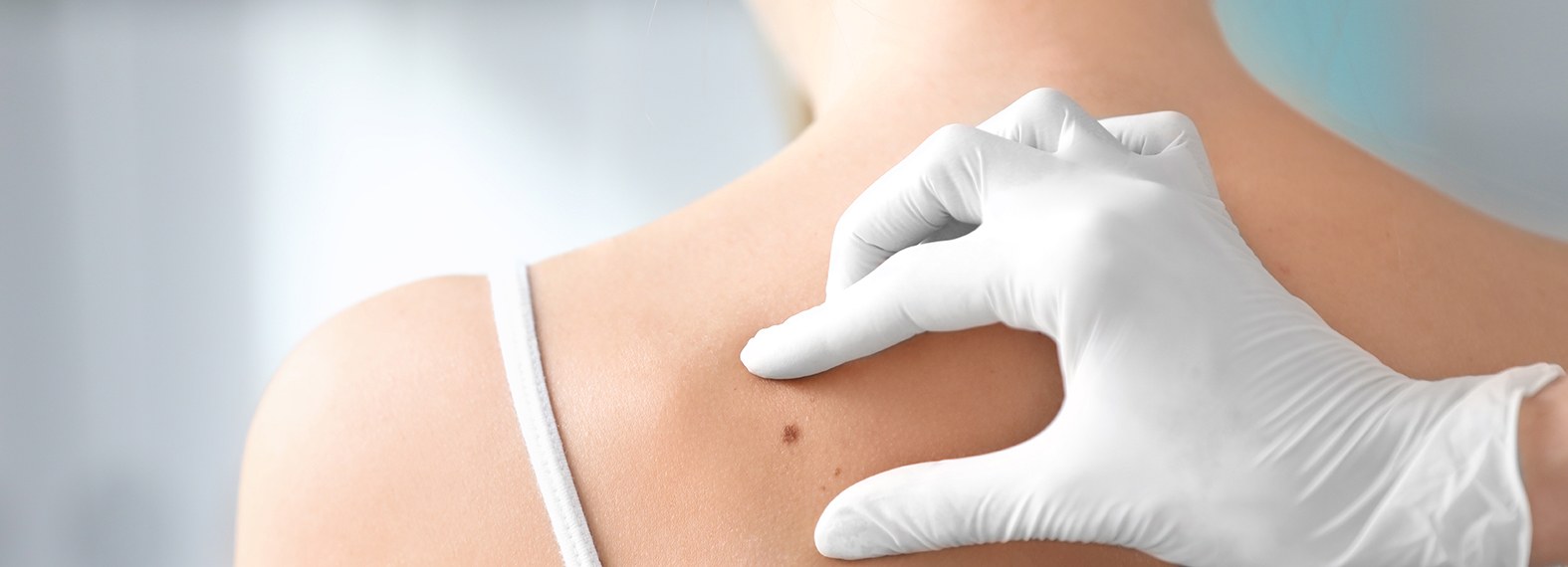Swiss Derma Clinic’s prevention programme enables malignant lesions to be spotted in the early stages – when the chances of clearing it up are the highest. Our skin cancer early detection programme includes:
Swiss Derma Clinic’s prevention programme enables malignant lesions to be spotted in the early stages – when the chances of clearing it up are the highest. Our skin cancer early detection programme includes:
Dr Evangelia Georgouli, a dermatology and venereology specialist registered with the FMH Swiss Medical Association, and a member of the International Dermoscopy Society, has many years’ experience of conventional and digital dermoscopy.


A regular mole check check (skin cancer screening) is part of the mandatory annual cancer screening programme. Unlike most other cancers, altered moles can be quickly and easily detected by a specialist examination. The chances of treatment are very good and the earlier a change is detected, the better. At the Swiss Derma Clinic in Zurich we carry out birthmark checks with a powerful dermatoscope. This allows us to detect skin tumours very reliably. With the computer-assisted digital video dermatoscopy, the progress can be documented and precisely assessed with regular birthmark checks.
Procedure of the mole check in Swiss Derma Clinic in Zurich:
At the Swiss Derma Clinic in Zurich, we use the latest computer-assisted digital video dermatoscopy. Conspicuous skin changes and pigmentation marks are digitally recorded and analysed. We carefully save the images. This enables our dermatologists to precisely compare possible changes over years. As a rule, the next check-up appointment should take place after 8 to 12 months.
Regular birthmark checks can detect skin cancer at an early stage and treat it effectively. Skin cancer screening is therefore one of the most effective preventive examinations. Nevertheless, many patients do not take advantage of these opportunities. Skin cancer is the most common form of cancer worldwide, and the number of cases has been increasing continuously for years. This is not least due to our beauty ideal of tanned skin.
Tanned skin is wrongly associated with health and sportiness. Recreational and outdoor activities often take place without adequate sun protection. Intensive and regular sun exposure and visits to solariums promote the development of this disease. Skin cancer is not a disease of old age - even young patients should remember to have their moles checked regularly. Ideally, the moles should be checked once a year by an experienced dermatologist.
Basically, our skin is subject to constant change. To a certain extent, the formation of new moles is therefore quite normal. Nevertheless, you should observe new birthmarks and point them out at your next birthmark check-up. The aim of the annual specialist examination is to reliably detect skin cancer and precancerous lesions and, if necessary, to treat them at an early stage. If skin cancer is detected in the early stages, the chances of cure are very good. Changes that you should be aware of are best described using the ABCDE rule:
In case of doubt and if you are worried about a birthmark, you can always make an appointment for a birthmark check at the Swiss Derma Clinic in Zurich.
Da sich im Grunde jedes Muttermal verändern kann, sollte eine detaillierte Kontrolle regelmäßig erfolgen. In der Swiss Derma Clinic in Zürich empfehlen wir die Muttermalkontrolle einmal pro Jahr. Für Ihre optimale Untersuchung verbinden wir die Blickuntersuchung unserer erfahrenen Fachärztin mit der mikroskopischen Untersuchung durch die digitale Videodermatoskopie.
Zusätzlich sollten Sie Ihre Muttermale selbst beobachten. Zum Beispiel können Sie mithilfe der ABCDE Regel Veränderungen erkennen. Auch wenn ein Muttermal neu auftritt oder Sie sich an einem bestehenden Pigmentfleck verletzt haben, sollten Sie einen Facharzt oder eine Fachärztin zur Kontrolle Ihrer Muttermale aufsuchen.
Falls in Ihrer Familie Hautkrebs vorkommt oder bei Ihnen bereits Hautkrebsvorstufen oder Hautkrebs diagnostiziert wurde, dann sind engmaschigere Untersuchungen sinnvoll. Unsere Fachärztin bespricht mit Ihnen bei Ihrem Termin ausführlich Ihr persönliches Risiko und gibt Ihnen eine Empfehlung zu den Untersuchungsintervallen.
Grundsätzlich gibt es kein Mindestalter für die Muttermalkontrolle. Bereits bei Kleinkindern können Sie die Muttermale kontrollieren lassen, eine regelmäßige jährliche Untersuchung ist hier jedoch in aller Regel nicht nötig. Da sich bei Kindern und Jugendlichen Muttermale mitunter stark verändern, kann die computergestützte digitale Videodermatoskopie hilfreich sein, um Hautveränderungen über die Jahre hinweg zu beobachten und zu dokumentieren.
Darüber hinaus empfehlen wir jedem Erwachsenen, sich regelmäßig einer Muttermalkontrolle durch eine Fachärztin oder einen Facharzt zu unterziehen. In Ihrer Erstuntersuchung legen wir Ihr persönliches Risikoprofil an. Personen mit heller und sonnenempfindlicher Haut, vielen Muttermalen und gehäuften Sonnenbränden in den vergangenen Jahren haben ein erhöhtes Erkrankungsrisiko.
Die Kosten für die jährliche Muttermalkontrolle in der Swiss Derma Clinic in Zürich werden von Ihrer Krankenkasse übernommen. Kürzere Untersuchungsintervalle sind möglich, wenn bei Ihnen ein erhöhtes Risiko für eine Hautkrebserkrankung vorliegt. Bei einem Verdacht auf eine bösartige Veränderung übernimmt die Grundversicherung die Untersuchungskosten auch in der Zwischenzeit.
Planen Sie für Ihre Untersuchung bei uns mindestens 20 Minuten ein. Darüber hinaus können Sie sich jederzeit an uns wenden, sollte Ihnen in der Zwischenzeit eine Veränderung an einem Muttermal Sorge bereiten. Neben medizinisch notwendigen Muttermalentfernungen entfernen wir auch kosmetisch störende Muttermale sowie Warzen, Lipome oder Zysten. Kosmetische und ästhetische Eingriffe sind keine Kassenleistungen.
Other treatments: